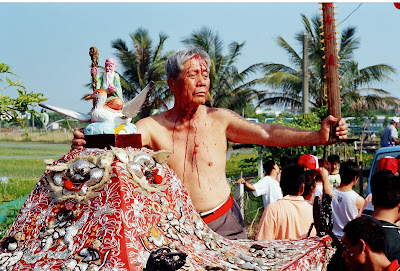
A Taiwanese tradition takes on special significance this year.
Global Post, May 15, 2009
XIGANG TOWNSHIP, Taiwan — Forget quarantines and Tamiflu. In southern Taiwan, the best, tried-and-true way to keep pestilence away: Burn a boat.
Not just any boat, mind you. For the best results, you need an elaborately decorated boat bearing effigies of the plague gods — a.k.a. the "Cholera Kings."
It's a folk ritual dating back at least 160 years here — much longer in southeast China — and it's performed every third spring on schedule.
But amid lingering swine flu fears, this year's "King-boat burning" took on an added timeliness.
"In 2003, there was the SARS epidemic, and in 2006, there was a pig flu in this area," said Ting Jen-chieh, an expert on Chinese folk religion at Academia Sinica. "After this ritual those diseases decreased — so people here believe it was because of the plague gods."
There haven't been any confirmed cases of swine flu in Taiwan. But with memories of SARS still fresh (it killed more than 70 people here), the island remains on edge.
The most recent scare came after Hong Kong's second confirmed case of H1N1. Seven Taiwanese passengers sat near the victim on a San Francisco to Hong Kong flight, and then traveled onward on a separate May 11 flight to Taiwan.
All were tracked down and determined to be disease-free later that week.
Not all locals here in southern Taiwan really believe boat-burning will drive away disease, of course.
But the community still embraces the ritual. On May 11 I witnessed hundreds of locals pulling the boat (on a wheeled platform) with two long ropes. Elderly, middle-aged, 20-something Taiwanese — all joined in.
Walking alongside them was James Chan, 70, visiting the boat-burning for the first time, and sporting a traditional conical farmer's hat for shade. "It's unbelievable, all these people pulling together," Chan said. "It's powerful."
Chan had just returned from overseas, stopping in Japan. He said airport controls were tight there, amid the swine flu scare. Inbound flights waited on the tarmac, as biohazard-suit-clad Japanese health workers checked each passenger's information and condition.
We walked with the villagers as they pulled the boat to a lot outside town. There, a mind-boggling pile of "ghost money" awaited, to serve as the boat's pyre.
The boat was lowered onto the pile with a crane. Locals stacked the money and fitted the boat with masts. A fire was lit, and the boat went up in a furious blaze.

Locals gave him conflicting accounts of the boat-burning. The most common one: Taoist priests tricked the plague demons by worshipping them as gods — then destroyed them in a burst of fire to protect the community. Jordan wrote, "Flattery and worship are accomplished for three days upon the demons, who are gradually lulled off their guard and become vulnerable.
"Late in the evening of the third day the priests file into the temple, where the demons of disease are at rest. Quickly the demons are captured by spells and chants and confined to a paper and wood ship, so that they are no longer free to roam the countryside working disaster on its inhabitants.
"On the following morning the ship … is hauled to the middle of a field in the village of Poplar Camp, traditionally considered to be the ancient shore line, and is ceremonially burnt and thus destroyed, demons and all."
More than three decades later, that ritual remains intact, says Academia Sinica's Ting.
There are only a few modern touches: A construction crane to lift the boat onto its burn-here spot, and a mini-bulldozer to help pile up the "ghost money" around the boat.
For the past year Ting has been living in the same village as Jordan did, noting how customs have changed. A few are in decline: There's a serious shaman shortage now, for example, as the occupation loses its past prestige.
But many folk beliefs are remarkably resilient.
"He [Jordan] predicted Chinese folk religion wouldn't change — and I've confirmed his prediction," Ting said. "At least in this agricultural area, the traditional way of explaining things is still very strong."
This, despite the island's vault to first-world status.
Just an hour or so drive away, factories churn out liquid-crystal display panels in a high-tech science park. Here, Taoist priests busy themselves trapping the Cholera Kings in paper and wood.
Why a boat? "A boat can bring the plague, but also carry the plague away," Ting explained as we watched the smoldering ashes, and waited for the charred mainmast to fall.
With pestilence like swine flu now spread worldwide via jumbo jet, maybe they should start burning a mock 747 instead.




















No comments:
Post a Comment